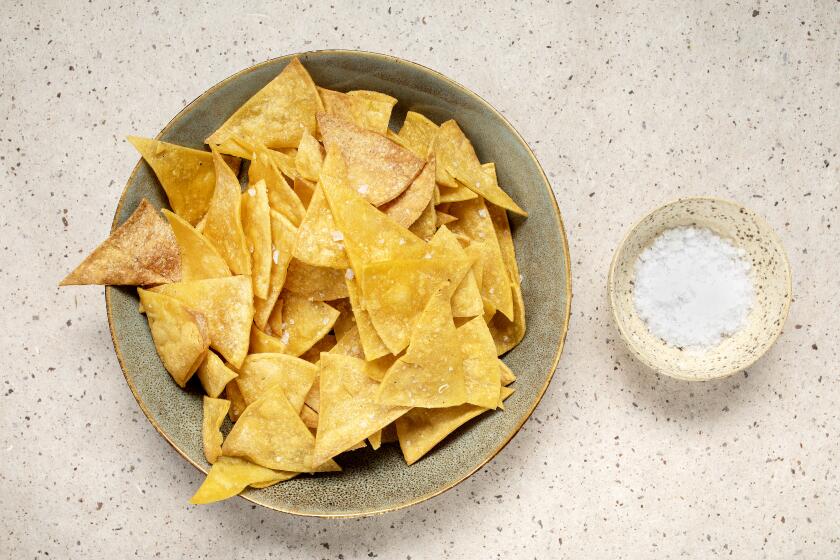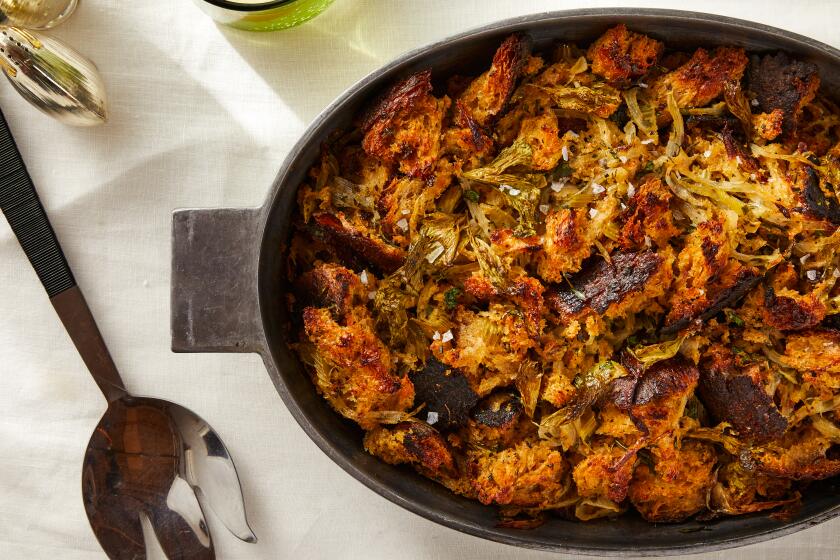Reginette della Mamma

- Share via
Loredana Cecchinato makes pasta like nobody’s business.
Made with a special Italian flour, Cecchinato’s pasta is tender and supple, silky and light -- well worth traveling across town for, especially if you order not one of the dishes on the menu, but her by-request-only Paduan reginette with Treviso radicchio and guanciale.
When Cecchinato’s son Filippo Cortivo took over La Buca from the original owner, the first thing he imported from Padua was Mamma, as everyone calls her.
On Melrose just east of Paramount Studios, La Buca is a postage-stamp of a space with simple wooden slat chairs and 11 tiny tables with red-and-white tablecloths. The largest things in the room are oversized photos: There’s the former owner posing with Peter Falk, an amusing still from Fellini’s “Armarcord,” and several beloved Italian movie stars, such as Valentino, Sophia, Marcello (and for some reason, Roberto Benigni). But there are plans to knock down walls and expand. They may even sell Mamma’s fresh pasta to go. Please, God, let them sell Mamma’s fresh pasta to go.
The pasta at La Buca is made from whole eggs, “00” (or double zero) flour and salt. The “00” flour is a purer, finer sift, lower in gluten and twice as expensive as regular flour. It makes a softer and more delicately flavored noodle. Cecchinato, who keeps a close watch over every penny the restaurant spends, has deemed it worth the expense. You can find “00” flour at Claro’s Italian Market (six locations, for information call [800] 507-0450), in Culver City at Sorrento Italian Market and at Surfas.
Mamma and Filippo are tied at the hip, living and working together while they try to figure out how to bring over the rest of the family, a father and an ailing but strong-willed grandmother who isn’t sure she wants to leave Italy (Filippo’s sister and brother-in-law are in Mexico after a Mafia run-in -- long story). “We are Italian,” says Filippo. “For us, family is life.”
Mamma, silver-haired with sparkling eyes and a musical voice, speaks no English but is a sociable woman who likes to talk to the people she is feeding. So Filippo translates for her. She quips that she had to learn to cook because she no longer looks the way she once did. She motions for Filippo to bring out the photos. Here is a glam shot of the gorgeous 17-year-old Cecchinato that makes the young Jane Fonda look dowdy. Then there is a 1975 photo of Loredana, the new mother, with her baby Filippo. “Before and after,” says Mamma, in one of the few jokes she has mastered in English.
*
A hands-on process
She would like to learn English, but she has no time. Maybe later, when the new chef Filippo has hired finally starts and the rest of the family gets here. For now, Cecchinato makes the pasta every day. Some days it’s reginette (about twice the breadth of fettuccine, but thinner, with frilly edges), some days tagliatelle, pappardelle, trenette, tagliolini, ravioli, gnocchi or a combination thereof. (For the time being, until they have more room for a large “pastamatic” machine, they use DeCecco dried pasta for other shapes, such as penne, rigatoni and farfalle.)
Mamma starts by putting her flour, eggs and salt in the bowl of an electric mixer. The proportion is one egg and a pinch or two of salt for every hundred grams (3.5 ounces) of flour. She mixes for 15 minutes.
The dough is ready, she says, when it is moist and elastic, easy to work with. It should be soft but not breaking into pieces. If it is sticking to your hands, it is too wet; add a little more flour. If it is not elastic, it is too dry: put it back in the mixer with another egg.
Next, she forms a ball of dough, poking her fingers into it to make sure it is not sticking to her digits. She then lets the dough, which is still warm from the mixer, rest for 15 minutes. Filippo says it needs to cool down to room temperature. You can also wrap it in plastic and put it in the fridge if you want to make it ahead; in that case, let it warm up to room temperature before proceeding.
Next Cecchinato cuts the dough into manageable balls, each about the size of a navel orange. She eschews the rolling pin because it hurts her hands; using her open palms, she pounds each ball into submission, throwing her entire weight into it and flattening the balls until they are each about one-fourth inch thick.
Then she rolls the dough through the manual pasta machine, first using the thickest setting; on most American models this will be the 1 setting. There is a bowl of flour nearby; she dusts the dough lightly almost every time she touches it -- this prevents sticking and helps ensure against bubbles and tears.
After she rolls the dough through once, she folds it lengthwise and rolls it through the thickest setting once again. Filippo searches through the dictionary to find the word for why she does this twice: It “amalgamates” better, is what he says. Then she takes the dough up the scale, rolling her dough through the 2 setting, the 3 setting, the 5 setting, the next-to-thinnest setting, and then, if it’s not thin enough for her, the thinnest. She then puts on the reginette (or desired pasta) cutter attachment and sends the dough through for the last time.
As her strands of reginette emerge like ribbons from the pasta machine, she fans them out wide with her floured fingers. The strands are so delicate I eat one raw, and it’s already tasty. You can only imagine how perfect it will be later, boiled for four or five minutes and sauced with a simple recipe from Venice, Vicenza or Rome, most likely adapted from La Cucini Italiana, a monthly magazine Cecchinato has been collecting since 1962.
Our favorite of Mamma’s sauces is the one from Padua, featuring Treviso radicchio (the slender, leafy variety), sausage, guanciale and a bit of cream. The idea of adding guanciale, or cured pork cheek, she says, was hers. It can be difficult to find. Filippo buys it from Guidi Marcello Co. Ltd. in Santa Monica ([310] 452-6277). This is a wholesale store, but they may sell you guanciale if you say Filippo sent you. (The home cook can always substitute salt pork.) It makes a wonderfully flavorful and surprisingly light sauce (you can just barely detect the cream) on a remarkably tender pasta. The combination is delizioso. Molto, molto, molto. Padua’s loss, Hollywood’s gain.
Combine the flour, eggs and salt in a large bowl. Mix by hand or with an electric mixer (with the dough hook) until the dough is smooth. It should be moist; if it seems too dry, add another egg. If too wet, add flour. Form it into a ball. Let rest 15 minutes.
Cut the dough into 8 pieces and flatten each slightly. Put each piece through the pasta machine twice on the widest setting, then once each on each progressively thinner setting, to make the sheets as thin as possible without tearing. Lay each sheet out on a floured baking sheet and cover with a kitchen towel. Continue to roll out the remaining dough.
Attach the reginette attachment to the pasta maker and cut the pasta into half-inch-wide strips 8 inches long. (Or cut the pasta by hand using a fluted pastry cutter.) Separate the strands with your fingers and sprinkle with flour and spread the pasta out straight on a baking sheet; cover with a towel until ready to cook.
Cook in rapidly boiling salted water for 3 to 4 minutes until al dente and serve.
Get our Cooking newsletter
Get a taste of Los Angeles — and the world — with recipes and kitchen tricks from the L.A. Times’ Cooking newsletter.
You may occasionally receive promotional content from the Los Angeles Times.















